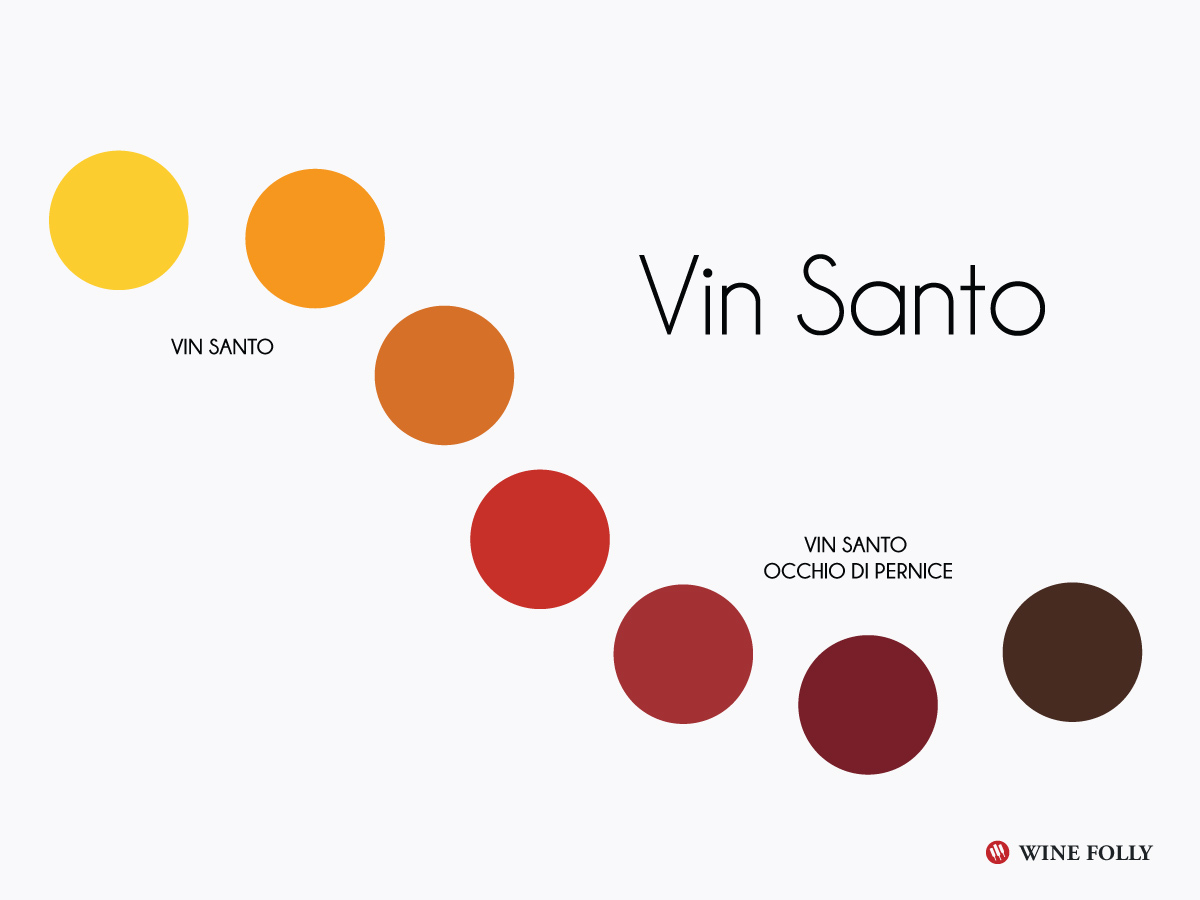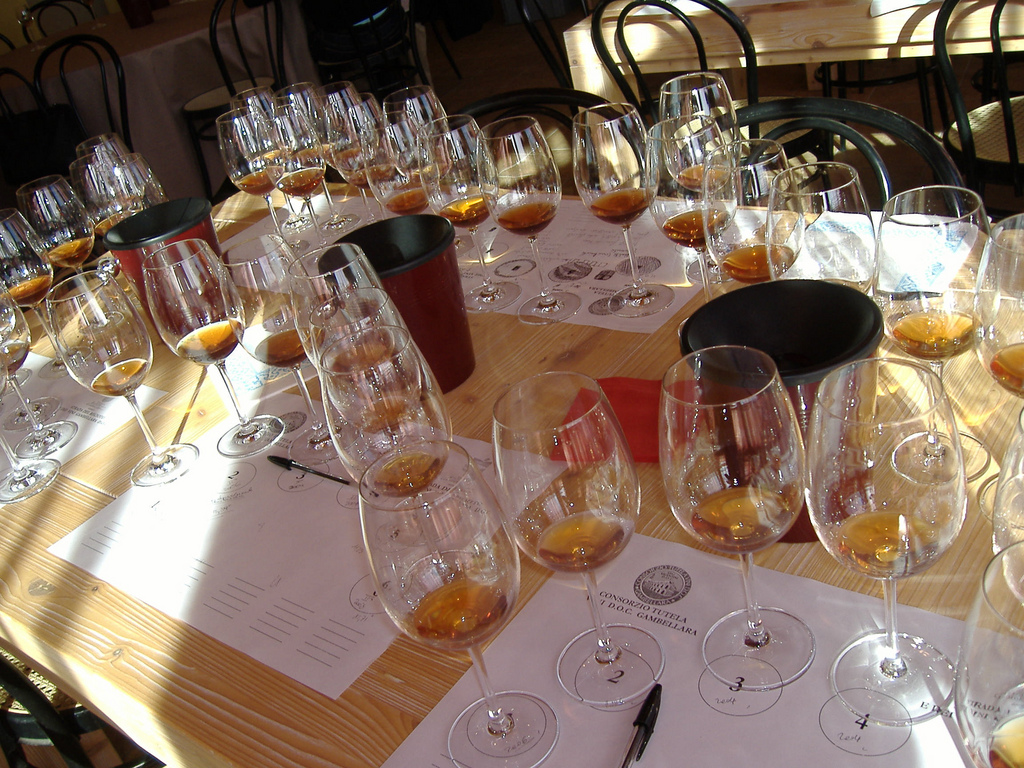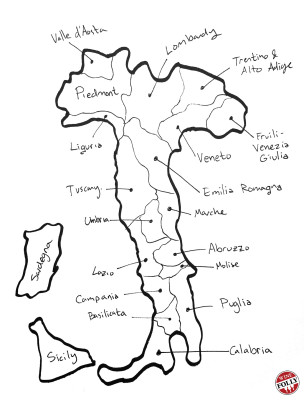Vin Santo (or Vino Santo) is a viscous, typically sweet dessert wine made in Italy, predominantly in Tuscany. The wine is loved for its intense flavors of hazelnut and caramel. When paired with biscotti, Vin Santo becomes “Cantucci e Vin Santo” which is inarguably Italy’s most famous welcoming tradition. What makes Vin Santo truly special is the natural winemaking process which gives it a unique taste.
FYI: Italian Vin Santo is not related to Vinsanto the Greek dessert wine, even though they do have a very similar name.
Vin Santo Wines of Italy

Vin Santo ranges in color from pale gold to deep auburn brown.
Vin Santo is a full-bodied, typically very sweet dessert wine with aromas of hazelnut, caramel, honey, tropical fruit, perfume and dried apricot. It’s one of those wines that sticks to the side of your glass and yet, when you taste it there’s this crazy balance between its delicacy and its intensity. Because of its unusually high sweetness, you don’t need much, just a 3 oz (75 ml) pour is enough to warm you while sitting in the snow.

“Cantucci e Vin Santo” –traditional welcoming delights served at special events. Salvadonica is a hotel in Tuscany who makes their own.
Vin Santo is best served after dinner…
or at tea-time…
or in a hot tub in the snow…
Where does it come from? What’s the history?
Vin Santo is produced primarily in Tuscany but you can find it in nearly all of Italy and with other notable producers found in both Veneto (using Garganega grapes) and Trentino (using Nosiola grapes). The tradition of Vin Santo is very old and there are several theories as to how the name came to be named “Holy Wine.” Our favorite theory (and perhaps the most logical one) is based on the timing of the fermentation of Vin Santo grapes around Easter in the spring.
How is Vin Santo made?

The process of making Vin Santo is something of a miracle. Grapes are laid out on mats, or hung in the rafters of the winery, to dry for many months in a process referred to as “passito.” Then, the raisins are pressed and placed into special barrels called Caratelli (translates to “small casks”) where they sit and wait for a natural fermentation to begin. As the rooms increase in temperature in the spring the Vin Santo fermentation begins. It is a long and slow fermentation that can rise and fall with the seasons and take up to 4 years to complete. The Vin Santo barrels are special in that over time they will develop their own yeast “mother.”
Enthusiasts of this wine will note that because of this uncontrolled winemaking process it means there is high variability between different producers. Some wines are nearly dry (not sweet), with sharp-tasting alcohol around 18–19% ABV. Other producers make extremely sweet wines around 220 g/L RS (think syrup) with about 14% ABV. So pay close attention to the details when picking out a bottle.
There is a fortified style called Vin Santo Liquoroso. And while a few producers make quality wines, most Liquoroso are low quality.
What is Vin Santo made of?

A wine tasting of Vino Santo from Gambellara made with Garganega grapes. by Fabio Ingrosso
There are many regions of Italy that produce Vin Santo using their own unique indigenous grapes.
In Tuscany, and part of Umbria and Marche, Vin Santo is typically made with a blend of Trebbiano (which adds honeyed flavors) and Malvasia (which adds lovely perfumed notes) although other white regional grapes can be used. There is also a red Vin Santo called Occhio de Pernice (“Eye of the Partridge”) made mostly with Sangiovese and a red type of Malvasia grape called Malvasia Nera.
In Veneto, the wine region of Gambellera makes a Vin Santo with the Soave grape, Garganega.
In Trentino, there is a rare aromatic grape called Nosiola which tastes somewhere in-between Viognier and Gewürztraminer that goes into Vin Santo di Trentino.
In Marche, you can find several Vin Santo made similar to Tuscany, but the unique one is called Vin Santo di Offida which is made with the rare Passerina grape which, as a dry wine, has notes of sweet Meyer lemons and fresh fennel.
Love Vin Santo? Check out these alternatives
Vin Santo isn’t the only Italian wine produced with the passito method. If you like this style, be sure to look into these other fascinating alternatives:

- Marche
- Verdicchio dei Castelli de Jesi Passito
Lacrima di Morro d’Alba Passito (a red!) - Lombardy
- Valcelepio Moscato Passito
Lugana Moscato Passito - Piedmont and Aosta Valley
- Piemonte Moscato Passito
Valle d’Aosta Moscato Passito - Sicily
- Erice Passito (Muscat of Alexandria grapes)
- Sardinia
- Carignano del Sulcis Passito (a red!)

Explore Italy’s wine regions
See what wines grow where on a detailed map of Italy
Map of Italian wine regions